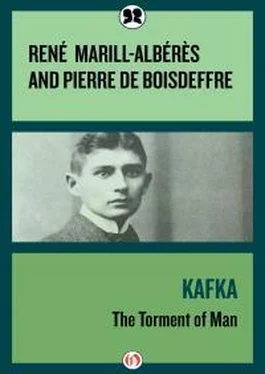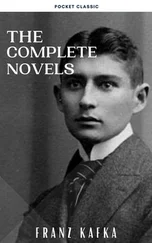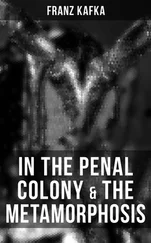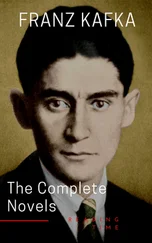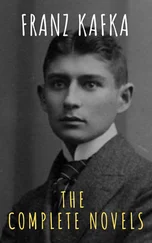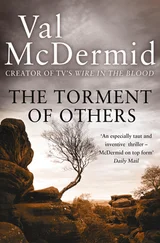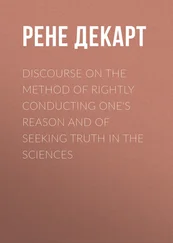Then the plot thickens and becomes phantasmagorical: after wandering through the city for a few hours and agreeing to go for a walk in the country, K. suddenly becomes afraid (why?) that his friend will take advantage of the darkness and kill him.… He runs, falls, gets up, and we discover him again in the next chapter, fleeing in the darkness, perched on the neck of a person whom he has taken as an animal for riding, whom he treats somewhat sadistically, and who must be the Friend (although there is nothing which will enable us to be certain about this). Furthermore, the second chapter has a revealing title: “Diversion, or Impossibility of Life.” Everything is going to become more and more improbable, but this very lack of realism is explained in the title: since stable, rational, regular life is the illusion under which we hide our anguish and the futility of our destiny, we can depict this life only by transforming it into a disconnected succession of illogical events.
The animal ridden by K. breaks down and is not seen again. K. falls asleep in the country, but this region near the city is transformed into an almost virgin setting. At dawn K. awakens beside a stream and sees a fat man on a litter carried by four naked men. The crossing proves fatal to this quintet: the porters drown, the litter is seized by the current which forces it toward a cataract. But K. has remained on the bank, and before slipping into the whirlpool, the fat man has time to deliver very calmly and in a narrative style (even though he is on the point of drowning) some explanations and reports that take up twenty-four pages of the text. (These stories were published by Kafka in 1909 under the titles “Conversation with the Praying Man” and “Conversation with the Drunkard”; each has its own unity even though the meaning remains elusive.) After taking an hour and a quarter to drift to the cataract, the Fat Man is swallowed up; K., who has been listening to him from the bank, makes no move to save him. Afterwards K. again finds the Friend who had accompanied him as he left the party the previous night and returns to town with him. But the Friend plunges a knife into his own arm as he says goodbye, and goes away, disheartened.
The narrator rarely, except for a brief lyrical passage, abandons the simple, somewhat pedantic tone of a man telling a logical tale. Here we see Kafka’s involuntary procedure: without abandoning the tone of realism—each episode has the ring of truth—he links together episodes which do not form a coherent story in the mind of a rational man. German Romanticism, the symbolist period (to which Kafka belongs), surrealism, films like The Blood of a Poet have accustomed us to such sequences. One might still ask, however, what Kafka is trying to communicate.
His aim is in no way didactic. The simple truth is that he knows and senses that life is not so coherent and rational as upright people—heads of families, successful men—try to make themselves believe. Spontaneously, without intending to startle the reader (“Description of a Struggle” was never published during his lifetime), he changes a story with a realistic beginning into a baffling narrative. More than other writers, because he is not trying to play tricks on the reader, he feels himself powerless in the face of life. Yet he refuses to impose on it the false superficial logic which comforts men secure in their existence: “I am incapable of bearing up under the assault of my own life, the aggression of time and old age, the vague impulse of the pleasure of writing, insomnia, flirtation with madness.” 11The incoherent brutality of Kafka’s tales is not that of madness but that of lucid anguish. Moreover, he confides to Max Brod: “ What I have to do, I can do only alone. Become clear about the ultimate things .” 12This illuminates all of Kafka’s works, including his first writings: even though men may live according to their petty human logic, the definitive meaning of their acts remains in suspense; consequently our acts and the events that press upon us must not be painted with too much logic. We hasten to make them rational, but they remain unjustified. That is why the poet writes nonsensical things in which incoherence gives us an image of the absence of justification. And in this way he raises a question—the question of “ultimate things.”
Still, there was nothing disconcerting about the strange concatenation of episodes—in “Description of a Struggle” as well as in “Preparation for a Wedding in the Country”—when Kafka wrote these stories between 1906 and 1912. Taking up the uncanny, fantastical elements of the Märchen and using them in a new way (called “symbolist” in France), Hugo von Hofmannsthal had evolved a charming Viennese predecessor ( Prose Writing , 1907) to these brilliant and somber episodes. The Woman Without a Shadow dates from 1923, but in it we find the same grotesque and fantastic details as in Kafka’s first sketches. Like Kafka, he too was a part of the world but a stranger to the world, talkative and jovial but lonely and tortured. Hofmannsthal also wrote under the impulsion of a nervous imagination given to frequent shifts. Like the author of Meditation , he perceived only the unusual relationships in reality and transformed them into states of poetic anguish which in his case were even more charming and facile.
Was not Rainer Maria Rilke a spiritual kinsman of Kafka? Exacting and dreamy, also tormented, alternately impulsive and hesitant, he had written a work which Kafka must have known, The Stories of Prague (1899), to say nothing of New Tales (1907) and especially The Journey of My Other Self (1930). Also Kafka’s kinsman, at first a writer on the Jewish question, was Jakob Wassermann, who reacted against naturalism and reintroduced into literature the problem of personality, the individual’s torment.
Because Kafka was known to the public only after 1925, he is often assigned to the “expressionist” generation of Werfel and Hasenclever, characterized by revolt and aggressiveness. But Kafka belongs in fact to the previous generation of Hofmannsthal and Rilke and is scarcely the youngest of them. He is one of those who broke away from the naturalistic universe in order to re-establish the primacy of inner anguish over objective, social description. He is the successor and heir to the second generation of naturalists, the generation which, raised in the spirit of positivism, far from finding in it any certitudes, rediscovered anguish and pessimism: Knut Hamsun, Strindberg, J. P. Jacobsen, and even Ibsen.
Kafka does, of course, exhibit an individual, timeless vocation which links him to a “race” of men and a body of followers: Pascal, Sénancour, Lenau, Kleist, Kierkegaard, etc. But he also belongs to a literary moment—the moment of “despair” incorporated, as naturalism came to an end, in the works of the great Norwegian dramatists. French literature was scarcely affected by this European crisis, hidden by the arabesques of symbolism. But from pure symbolism, as it was interpreted by Hofmannsthal, for example, Kafka had taken the best part, the sense of esoteric writing. And from “despair” as it was interpreted at the end of the century—from despair which coincided with his vocation of suffering and which he freed from the pedantry of social and psychological description—he fashioned his inner life, his legend and his creation.
The young office employee who, in the solitude of his room, wrote obsessive, disconnected texts, still had not mastered the art of lucidity and continuity. After 1911, even as his personal crises became more acute (he met F. B. and entered a sanatorium for the first time), his genius took shape.
Disordered narration became ordered narration, the first form of myth. It was in 1911 that Kafka wrote a compact story, “The Verdict,” and drafted the first chapter of Amerika , which was published in 1913 under the title “The Stoker.” The same year he published Meditation , but he had already lost interest in this collection. In 1912 he began “The Metamorphosis,” and in 1913 The Judgment , which he dedicated to his fiancée.
Читать дальше
